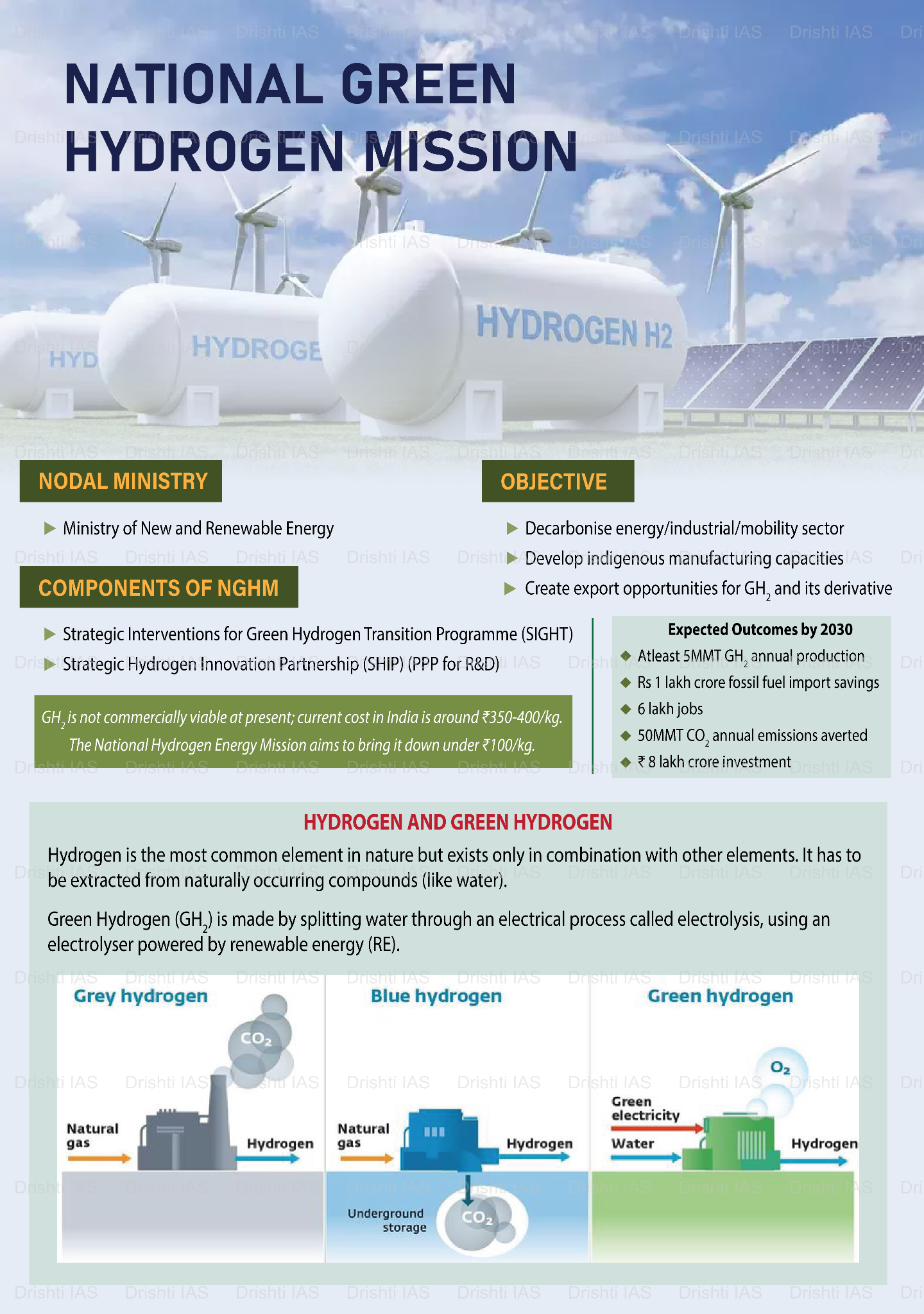National Green Hydrogen Mission | 24 Jun 2024
Why in News?
Recently, the Ministry of New & Renewable Energy (MNRE) has increased the yearly allocation of Green Ammonia for the fertiliser sector from 550,000 to 750,000 tonnes to meet rising demand, enhancing support for Green Hydrogen in India.
What is the National Green Hydrogen Mission (NGHM)?
- India launched the National Green Hydrogen Mission (NGHM) in January 2023.
- The Ministry of New & Renewable Energy (MNRE) is implementing the NGHM with a target to achieve a production capacity of 5 million tonnes per annum of Green Hydrogen in the country by the year 2030.
- The Strategic Interventions for Green Hydrogen Transition (SIGHT) programme, under NGHM, provides incentives for the manufacturing of electrolysers and the production of green ammonia.
- Under NGHM a dedicated portal was launched to provide information on the mission and steps for developing the green hydrogen ecosystem in India.
- India has also released scheme guidelines for the use of Green Hydrogen in steel, transport, and shipping sectors.
- The Department of Science and Technology has initiated Hydrogen Valley Innovation Clusters to foster innovation and promote the green hydrogen ecosystem in India.
Other Initiatives Related to Renewable Energy
What is Green Ammonia?
- About:
- Ammonia is a chemical that is used mainly in the manufacture of nitrogenous fertilisers, like urea and ammonium nitrate, but can be put to other uses too, such as to run engines.
- Green ammonia production is where the process of making ammonia is 100% renewable and carbon-free.
- Method of Production:
- It is produced by using hydrogen from water electrolysis and nitrogen separated from the air. These are then fed into the Haber process, all powered by sustainable electricity.
- Green ammonia production makes use of renewable energy sources such as hydroelectric, solar power or wind turbines.
- In the Haber process, hydrogen and nitrogen are reacted together at high temperatures and pressures to produce ammonia (NH3).
- It is produced by using hydrogen from water electrolysis and nitrogen separated from the air. These are then fed into the Haber process, all powered by sustainable electricity.
- Uses:
- Energy Storage: Ammonia is easily stored in bulk as a liquid at modest pressures (10-15 bar) or refrigerated to -33°C. This makes it an ideal chemical store for renewable energy.
- Zero-carbon Fuel: Ammonia can be burnt in an engine or used in a fuel cell to produce electricity. When used, ammonia’s only by-products are water and nitrogen.
- Marine Industry: The maritime industry is likely to be an early adopter, replacing the use of fuel oil in marine engines.
- Significance:
- Green ammonia is intended to be used in the production of carbon-neutral fertiliser products, decarbonizing the food value chain, and also has potential as a future climate-neutral shipping fuel.
- Green ammonia is crucial to tackling the existential challenges of producing enough food to feed a growing global population and generating CO2-free energy.
UPSC Civil Services Examination, Previous Year Question (PYQ)
Prelims:
Q. Hydrogen fuel cell vehicles produce one of the following as “exhaust” (2010)
(a) NH3
(b) CH4
(c) H2O
(d) H2O2
Ans: (c)

